Research on the Vitality Evaluation of Parks and Squares in Medium-Sized Chinese Cities from the Perspective of Urban Functional Areas
Abstract
1. Introduction
2. Overview of the Study Area and Data Sources
2.1. Study Area
2.2. Sources of Data
3. Research Methods
3.1. Research Framework
3.2. Quantitative Identification of Functional Areas
3.3. Travel Vitality Index of Urban Residents
3.4. Evaluation of the Levels of Service in Parks and Squares
3.5. Attractiveness Assessment of Parks and Squares
3.6. Weight Determination and Data Processing
4. Results and Analysis
4.1. Classification and Identification of Urban Functional Areas in the Main Urban Areas of Jiaozuo
4.2. Calculation of the Travel Vitality Index of Urban Residents
4.3. Evaluation of the Levels of Service of Parks and Squares
4.4. Analysis of Park and Square Vitality
5. Conclusions and Discussion
Author Contributions
Funding
Institutional Review Board Statement
Informed Consent Statement
Data Availability Statement
Conflicts of Interest
References
- Fischer, L.-K.; Honold, J.; Botzat, A.; Brinkmeyer, D.; Cvejić, R.; Delshammar, T.; Kowarik, I. Recreational ecosystem services in European cities: Sociocultural and geographical contexts matter for park use. Ecosyst. Serv. 2018, 31, 455–467. [Google Scholar] [CrossRef]
- Bolund, P.; Hunhammar, S. Ecosystem services in urban areas. Ecol. Econ. 1999, 29, 293–301. [Google Scholar] [CrossRef]
- Assessment, M.-E. Ecosystems and human well-being: Synthesis. Phys. Teach. 2005, 34, 534. [Google Scholar] [CrossRef]
- Neuvonen, M.; Sievänen, T.; Tönnes, S.; Koskela, T. Access to green areas and the frequency of visits—A case study in Helsinki. Urban For. Urban Green. 2007, 6, 235–247. [Google Scholar] [CrossRef]
- Erkip, F. The distribution of urban public services: The case of parks and recreational services in Ankara. Cities 1997, 14, 353–361. [Google Scholar] [CrossRef]
- Yu, Y.-E.; Yu, Z.; Zhang, L.; Akkelies, V.-N. Designing urban spatial vitality from morphological perspective-A study based on quantified urban morphology and activities’ testing. Urban Plan. Int. 2016, 1, 26–33. [Google Scholar]
- The Central People’s Government of the People’s Republic of China. Notice of the State Council on Adjusting the Standard of City Size Divisio. 2014. Available online: http://www.gov.cn/zhengce/content/2014-11/20/content_9225.htm (accessed on 12 December 2021).
- Rigolon, A.; Németh, J. “We’re not in the business of housing:” Environmental gentrification and the nonprofitization of green infrastructure projects. Cities 2018, 81, 71–80. [Google Scholar] [CrossRef]
- Zhang, C.; Juan, Z.; Lu, W.; Xiao, G. Do the organizational forms affect passenger satisfaction? Evidence from Chinese public transport service. Transp. Res. Part A: Policy Pract. 2016, 94, 129–148. [Google Scholar] [CrossRef]
- Zhang, C.; Wang, D.; Ni, A.; Ni, X.; Xiao, G. Different effects of contractual form on public transport satisfaction: Evidence from large- and medium-sized cities in China. Sustainability 2019, 11, 5453. [Google Scholar] [CrossRef]
- Prieto, C.-R.; Cabrera, A.-C.; Bishop, S.-R. Scaling beyond cities. Front. Phys. 2022, 10, 858307. [Google Scholar] [CrossRef]
- Vajjhala, S.-P.; John, A.-M.; Evans, D.-A. Determining the Extent of Market and Extent of Resource for Stated Preference Survey Design Using Mapping Methods. RFF Discuss. Available online: https://papers.ssrn.com/sol3/papers.cfm?abstract_id=1280945 (accessed on 8 October 2008). [CrossRef][Green Version]
- Jalaladdini, S.; Oktay, D. Urban public spaces and vitality: A socio-spatial analysis in the streets of cypriot towns. Procedia-Soc. Behav. Sci. 2012, 35, 664–674. [Google Scholar] [CrossRef]
- Rigolon, A.; Németh, J. A Quality Index of Parks for Youth (QUINPY): Evaluating urban parks through geographic information systems. Environ. Plan. B Urban Anal. City Sci. 2016, 45, 275–294. [Google Scholar] [CrossRef]
- Maroko, A.-R.; Maantay, J.-A.; Sohler, N.-L.; Grady, K.-L.; Arno, P.-S. The complexities of measuring access to parks and physical activity sites in new york city: A quantitative and qualitative approach. Int. J. Health Geogr. 2009, 8, 34. [Google Scholar] [CrossRef]
- Liu, M.; Han, L.; Xiong, S.; Qing, L.; Ji, H.; Peng, Y. Large-scale street space quality evaluation based on deep learning over street view image. In Proceedings of the International Conference on Image and Graphics, Beijing, China, 23–25 August 2019. [Google Scholar]
- Stubbings, P.; Rowe, F.; Arribas-Bel, D. A hierarchical urban forest index using street-level imagery and deep learning. Remote Sens. 2019, 11, 1395. [Google Scholar] [CrossRef]
- Wang, M.; He, Y.; Meng, H.; Zhang, Y.; Zhu, B.; Mango, J.; Li, X. Assessing street space quality using street view imagery and function-driven method: The case of Xiamen, China. ISPRS Int. J. Geo-Inf. 2022, 11, 282. [Google Scholar] [CrossRef]
- Yao, Y.; Liu, X.; Li, X.; Zhang, J.; Liang, Z.; Mai, K.; Zhang, Y. Mapping fine-scale population distributions at the building level by integrating multisource geospatial big data. Int. J. Geogr. Inf. Sci. 2017, 31, 1220–1244. [Google Scholar] [CrossRef]
- Dong, Y.-H.; Peng, F.-L.; Guo, T.-F. Quantitative assessment method on urban vitality of metro-led underground space based on multi-source data: A case study of Shanghai Inner Ring area. Tunn. Undergr. Space Technol. 2021, 116, 104108. [Google Scholar] [CrossRef]
- Liu, D.; Shi, Y. The influence mechanism of urban spatial structure on urban vitality based on geographic big data: A case study in downtown Shanghai. Buildings 2022, 12, 569. [Google Scholar] [CrossRef]
- Lv, G.; Zheng, S.; Hu, W. Exploring the relationship between the built environment and block vitality based on multi-source big data: An analysis in Shenzhen, China. Geomat. Nat. Hazards Risk 2022, 13, 1593–1613. [Google Scholar] [CrossRef]
- Fang, C.; He, S.; Wang, L. Spatial characterization of urban vitality and the association with various street network metrics from the multi-scalar perspective. Front. Public Health 2021, 9, 677910. [Google Scholar] [CrossRef] [PubMed]
- Wu, W.; Ma, Z.; Guo, J.; Niu, X.; Zhao, K. Evaluating the effects of built environment on street vitality at the city level: An empirical research based on spatial panel durbin model. Int. J. Environ. Res. Public Health 2022, 19, 1664. [Google Scholar] [CrossRef] [PubMed]
- Long, Y.; Huang, C. Does block size matter? The impact of urban design on economic vitality for Chinese cities. Environ. Plan. B Urban Anal. City Sci. 2017, 46, 406–422. [Google Scholar] [CrossRef]
- Liu, M.; Jiang, Y.; He, J. Quantitative evaluation on street vitality: A case study of Zhoujiadu community in Shanghai. Sustainability 2021, 13, 3027. [Google Scholar] [CrossRef]
- Williams, A.; Qiu, H. Exploring affecting factors of park use based on multisource big data: Case study in Wuhan, China. J. Urban Plan. Dev. 2021, 147, 05020037. [Google Scholar] [CrossRef]
- Williams, S.; Xu, W.; Tan, S.-B.; Foster, M.-J.; Chen, C. Ghost cities of China: Identifying urban vacancy through social media data. Cities 2019, 94, 275–285. [Google Scholar] [CrossRef]
- Zeng, C.; Song, Y.; He, Q.; Shen, F. Spatially explicit assessment on urban vitality: Case studies in Chicago and Wuhan. Sustain. Cities Soc. 2018, 40, 296–306. [Google Scholar] [CrossRef]
- Liu, S.; Zhang, L.; Long, Y. Urban vitality area identification and pattern analysis from the perspective of time and space fusion. Sustainability 2019, 11, 4032. [Google Scholar] [CrossRef]
- Guo, X.; Chen, H.; Yang, X. An evaluation of street dynamic vitality and its influential factors based on multi-source big data. ISPRS Int. J. Geo-Inf. 2021, 10, 143. [Google Scholar] [CrossRef]
- Chen, Y.; Liu, X.; Gao, W.; Wang, R.-Y.; Li, Y.; Tu, W. Emerging social media data on measuring urban park use. Urban For. Urban Green. 2018, 31, 130–141. [Google Scholar] [CrossRef]
- Wu, W.; Niu, X.; Li, M. Influence of built environment on street vitality: A case study of west Nanjing road in Shanghai based on mobile location data. Sustainability 2021, 13, 1840. [Google Scholar] [CrossRef]
- Othman, A.; Al-Hagla, K.; Hasan, A.-E. The impact of attributes of waterfront accessibility on human well-being: Alexandria Governorate as a case study. Ain Shams Eng. J. 2021, 12, 1033–1047. [Google Scholar] [CrossRef]
- Thompson, C.-W. Urban open space in the 21st century. Landsc. Urban Plan. 2002, 60, 59–72. [Google Scholar] [CrossRef]
- Brown, G.; Schebella, M.-F.; Weber, D. Using participatory GIS to measure physical activity and urban park benefits. Landsc. Urban Plan. 2014, 121, 34–44. [Google Scholar] [CrossRef]
- Goličnik, B.; Thompson, C.-W. Emerging relationships between design and use of urban park spaces. Landsc. Urban Plan. 2010, 94, 38–53. [Google Scholar] [CrossRef]
- Corti, B.; Donovan, R.; Holman, C. Factors influencing the use of physical activity facilities: Results from qualitative research. Health Promot. J. Aust. 1996, 6, 16–21. [Google Scholar]
- Donahue, M.-L.; Keeler, B.-L.; Wood, S.-A.; Fisher, D.-M.; Hamstead, Z.-A.; McPhearson, T. Using social media to understand drivers of urban park visitation in the Twin Cities, MN. Landsc. Urban Plan. 2018, 175, 1–10. [Google Scholar] [CrossRef]
- Zhang, S.; Zhou, W. Recreational visits to urban parks and factors affecting park visits: Evidence from geotagged social media data. Landsc. Urban Plan. 2018, 180, 27–35. [Google Scholar] [CrossRef]
- Schipperijn, J.; Bentsen, P.; Troelsen, J.; Toftager, M.; Stigsdotter, U.-K. Associations between physical activity and characteristics of urban green space. Urban For. Urban Green. 2013, 12, 109–116. [Google Scholar] [CrossRef]
- Koohsari, M.-J.; Mavoa, S.; Villanueva, K.; Sugiyama, T.; Badland, H.; Kaczynski, A.-T.; Giles-Corti, B. Public open space, physical activity, urban design and public health: Concepts, methods and research agenda. Health Place 2015, 33, 75–82. [Google Scholar] [CrossRef]
- Zhang, X.; Lu, H.; Holt, J.-B. Modeling spatial accessibility to parks: A national study. Int. J. Health Geogr. 2011, 10, 31. [Google Scholar] [CrossRef] [PubMed]
- Gu, X.; Tao, S.; Dai, B. Spatial accessibility of country parks in Shanghai, China. Urban For. Urban Green. 2017, 27, 373–382. [Google Scholar] [CrossRef]
- Vale, D.-S.; Pereira, M.; Viana, C.-M. Different destination, different commuting pattern? Analyzing the influence of the campus location on commuting. J. Transp. Land Use 2018, 11, 1–18. [Google Scholar] [CrossRef]
- Dallimer, M.; Davies, Z.; Irvine, K.; Maltby, L.; Warren, P.; Gaston, K.; Armsworth, P. What personal and environmental factors determine frequency of urban greenspace use? Int. J. Environ. Res. Public Health 2014, 11, 7977–7992. [Google Scholar] [CrossRef]
- Ríos-Rodríguez, M.L.; Rosales, C.; Lorenzo, M.; Muinos, G.; Hernández, B. Influence of perceived environmental quality on the perceived restorativeness of public spaces. Front. Psychol. 2021, 12, 644763. [Google Scholar] [CrossRef]
- Wang, Z.; Ma, D.; Sun, D.; Zhang, J. Identification and analysis of urban functional area in Hangzhou based on OSM and POI data. PLoS ONE 2021, 16, e0251988. [Google Scholar] [CrossRef]
- Hu, Y.; Han, Y. Identification of urban functional areas based on POI data: A case study of the Guangzhou economic and technological development zone. Sustainability 2019, 11, 1385. [Google Scholar] [CrossRef]
- Sairinen, R.; Kumpulainen, S. Assessing social impacts in urban waterfront regeneration. Environ. Impact Assess. Rev. 2006, 26, 120–135. [Google Scholar] [CrossRef]
- Breen, A.; Rjgby, D. The New Waterfront: A Worldwide Urban Success Story; Thames and Hudson: London, UK, 1996. [Google Scholar]
- Liu, S.; Lai, S.-Q.; Liu, C.; Jiang, L. What influenced the vitality of the waterfront open space? A case study of Huangpu River in Shanghai, China. Cities 2021, 114, 103197. [Google Scholar] [CrossRef]
- Ewing, R.; Cervero, R. Travel and the built environment: A meta-analysis. J. Am. Plan. Assoc. 2010, 76, 265–294. [Google Scholar] [CrossRef]
- Hoyle, B. Global and local change on the port-city waterfront*. Geogr. Rev. 2010, 90, 395–417. [Google Scholar] [CrossRef]
- Keith, M.; O’Clery, N.; Parnell, S.; Revi, A. The future of the future city? The new urban sciences and a PEAK Urban interdisciplinary disposition. Cities 2020, 105, 102820. [Google Scholar] [CrossRef]
- Peng, D.-C.; Zhang, S.-M.; Fang, Y.; Yin, Z.-S.; Chen, T.; Niu, Y.-F.; Zhong, L.-S.; He, Y.; Zhang, F. Classification, Investigation and Evaluation of Tourism Resources, 2nd ed.; Standards Press of China: Beijing, China, 2018. [Google Scholar]
- Xu, W.-J.; Yang, J.; Chen, T.-Y.; Ding, S.-F. Exploring and improving vigorous urban space based on youth behavior, Qingdao. Planners 2021, 37, 101–108. [Google Scholar]
- Liu, Y.-B.; Xu, S.-N.; Liu, W.-Q.; Li, G.-J. Vitality measurement and analysis of the influencing factors of waterfront blocks in Beijing based on multisource data. Archit. J. 2021, S01, 120–127. [Google Scholar]
- Zhao, W.; Li, Q.; Li, B. Extracting hierarchical landmarks from urban POI data. J. Remote Sens. 2011, 15, 972–988. [Google Scholar]
- Chen, X.; Li, X.-M.; Zhan, R.; Xu, W.-M. Studyingon extracting hierarchical landmarks from urban poi data. Geomat. Spat. Inf. Technol. 2015, 38, 129–132+136. [Google Scholar]
- Zhu, J.; Lu, H.; Zheng, T.; Rong, Y.; Wang, C.; Zhang, W.; Tang, L. Vitality of urban parks and its influencing factors from the perspective of recreational service supply, demand, and spatial links. Int. J. Environ. Res. Public Health 2020, 17, 1615. [Google Scholar] [CrossRef] [PubMed]
- Yue, Y.; Zhuang, Y.; Yeh, A.-G.-O.; Xie, J.-Y.; Ma, C.-L.; Li, Q.-Q. Measurements of POI-based mixed use and their relationships with neighbourhood vibrancy. Int. J. Geogr. Inf. Sci. 2016, 31, 658–675. [Google Scholar] [CrossRef]
- Mu, B.; Liu, C.; Mu, T.; Xu, X.; Tian, G.; Zhang, Y.; Kim, G. Spatiotemporal fluctuations in urban park spatial vitality determined by on-site observation and behavior mapping: A case study of three parks in Zhengzhou City, China. Urban For. Urban Green. 2021, 64, 127246. [Google Scholar] [CrossRef]
- Li, S.; Wu, C.; Lin, Y.; Li, Z.; Du, Q. Urban morphology promotes urban vibrancy from the spatiotemporal and synergetic perspectives: A case study using multisource data in Shenzhen, China. Sustainability 2020, 12, 4829. [Google Scholar] [CrossRef]
- Kang, C.-D. Effects of the human and built environment on neighborhood vitality: Evidence from Seoul, Korea, using mobile phone data. J. Urban Plan. Dev. 2020, 146, 05020024. [Google Scholar] [CrossRef]
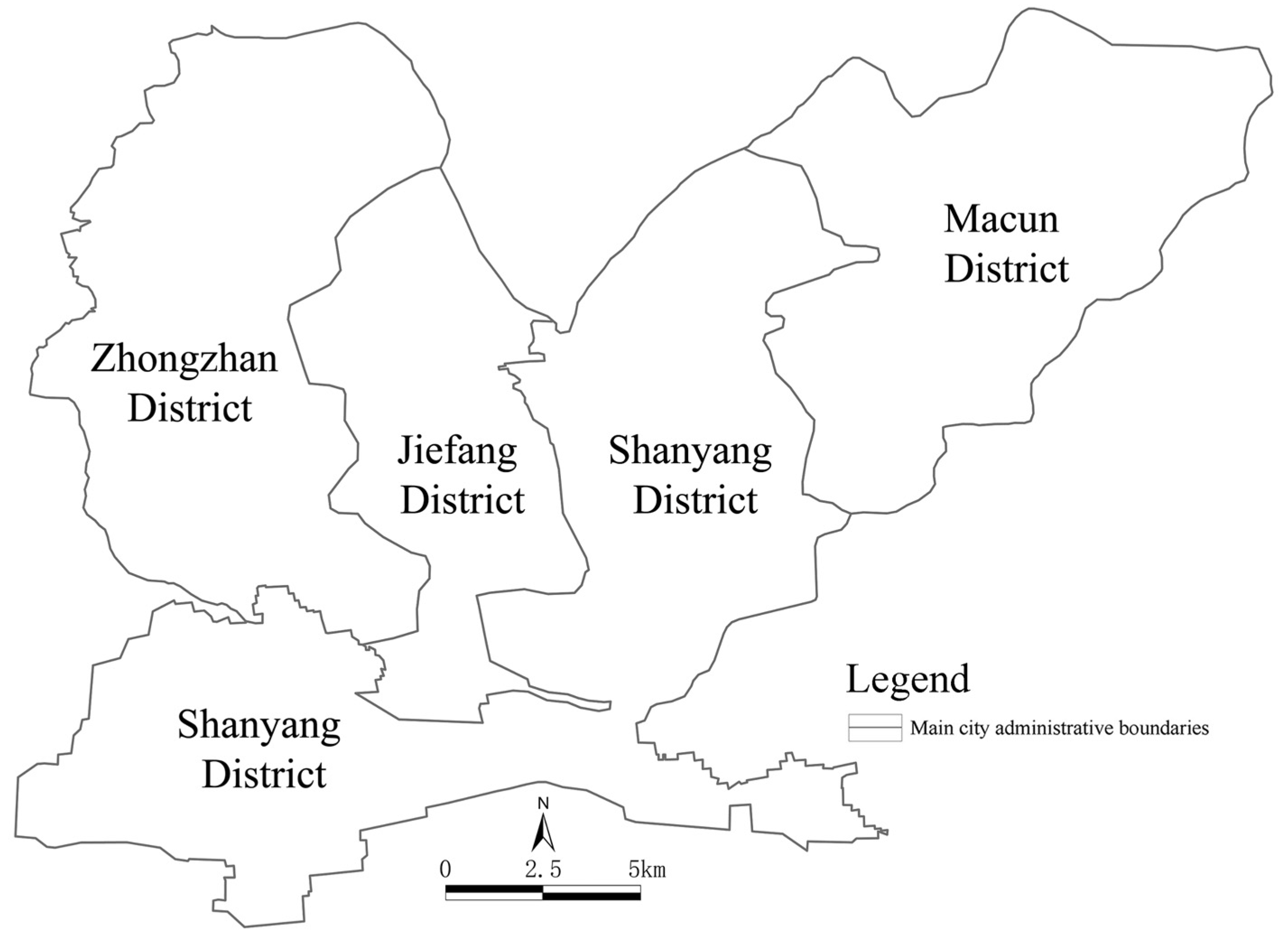
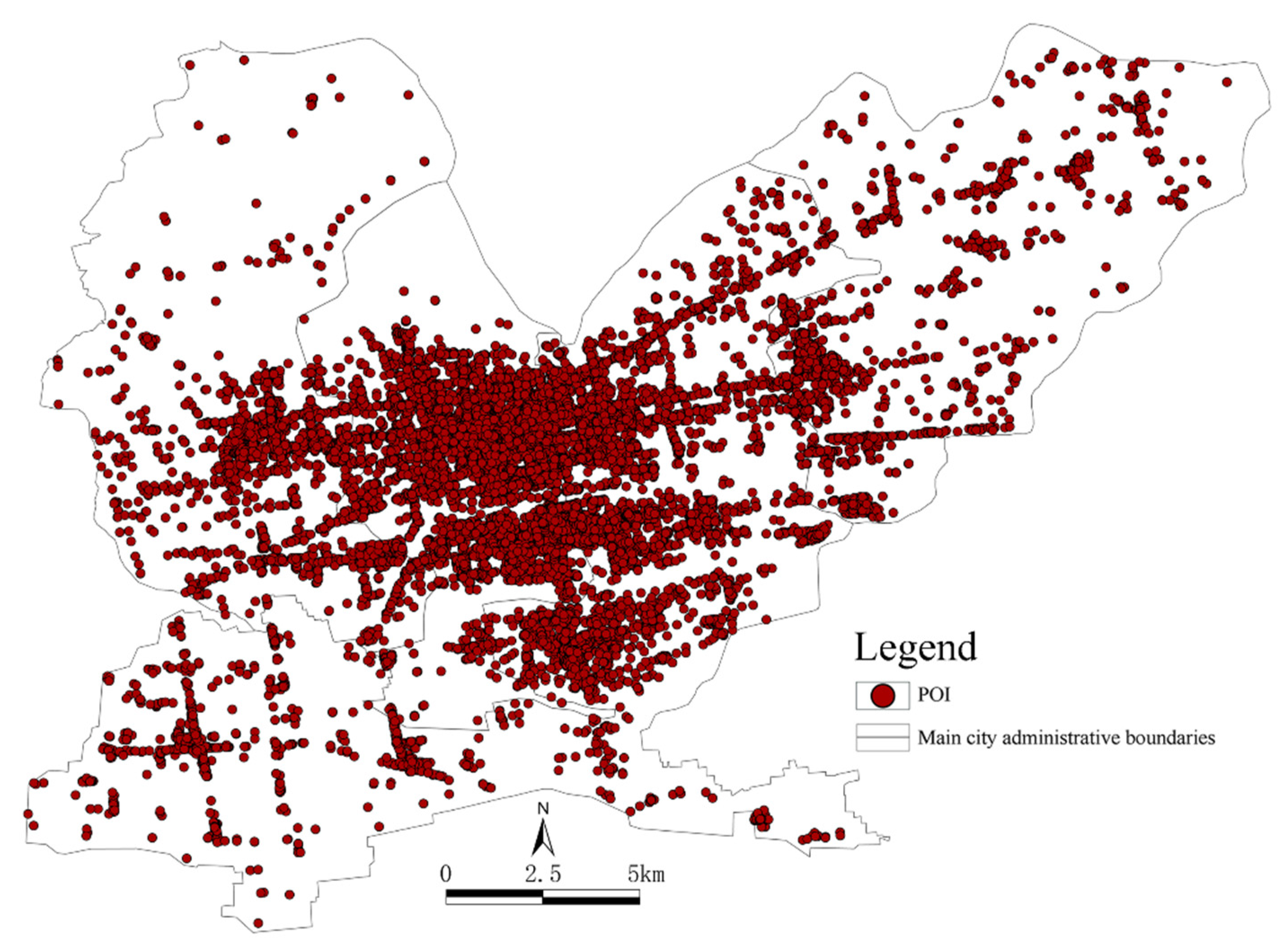
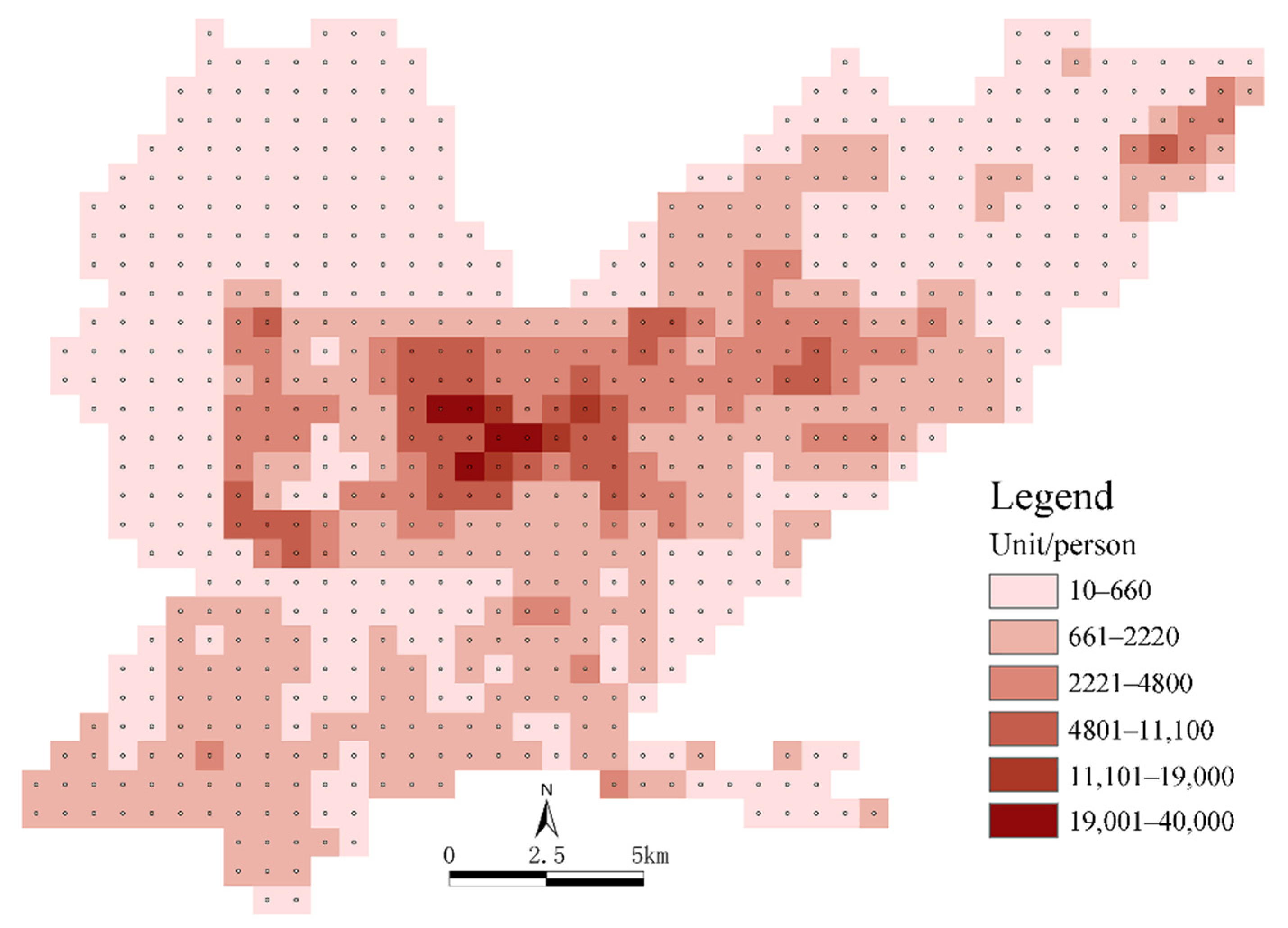

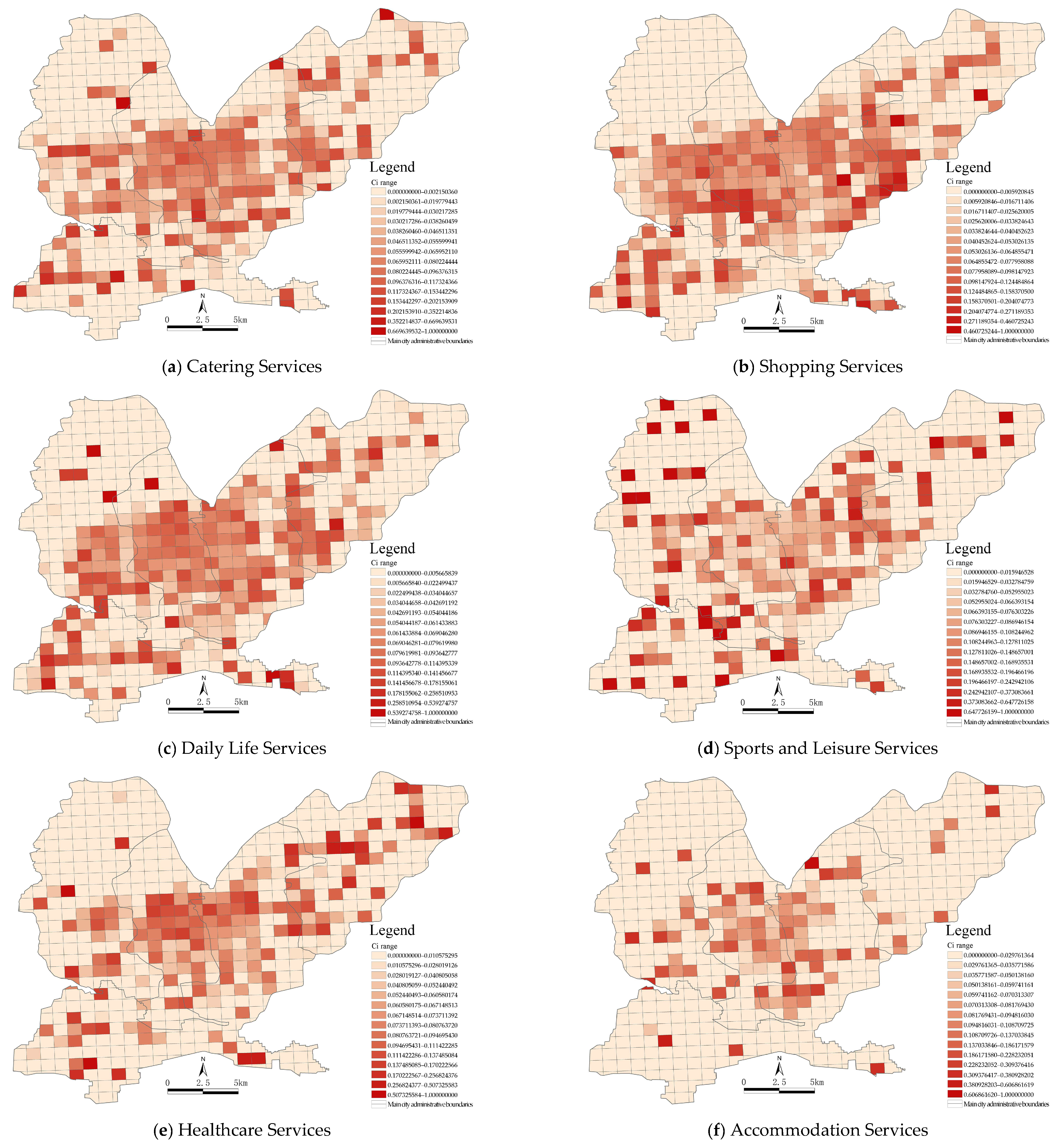
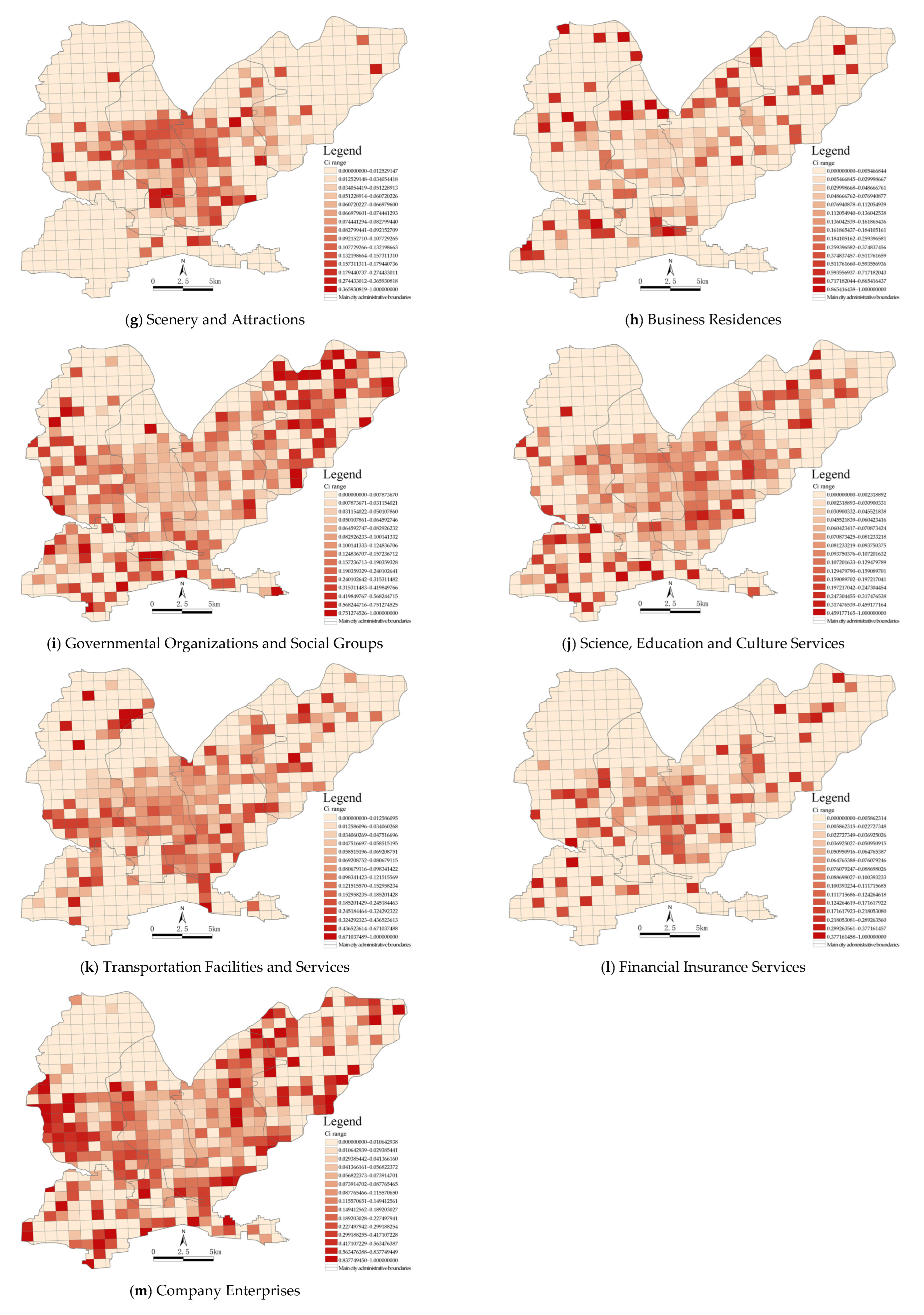
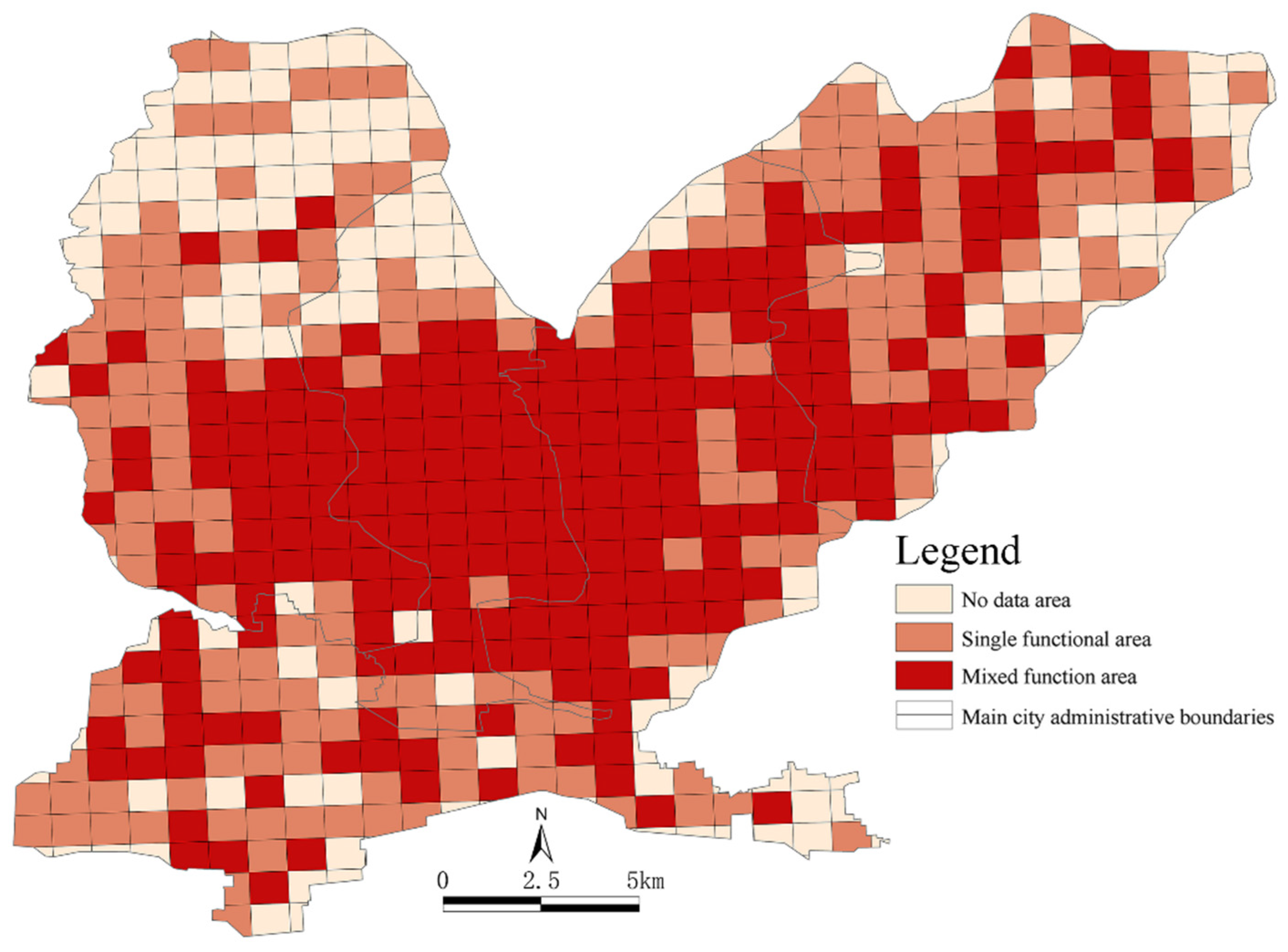
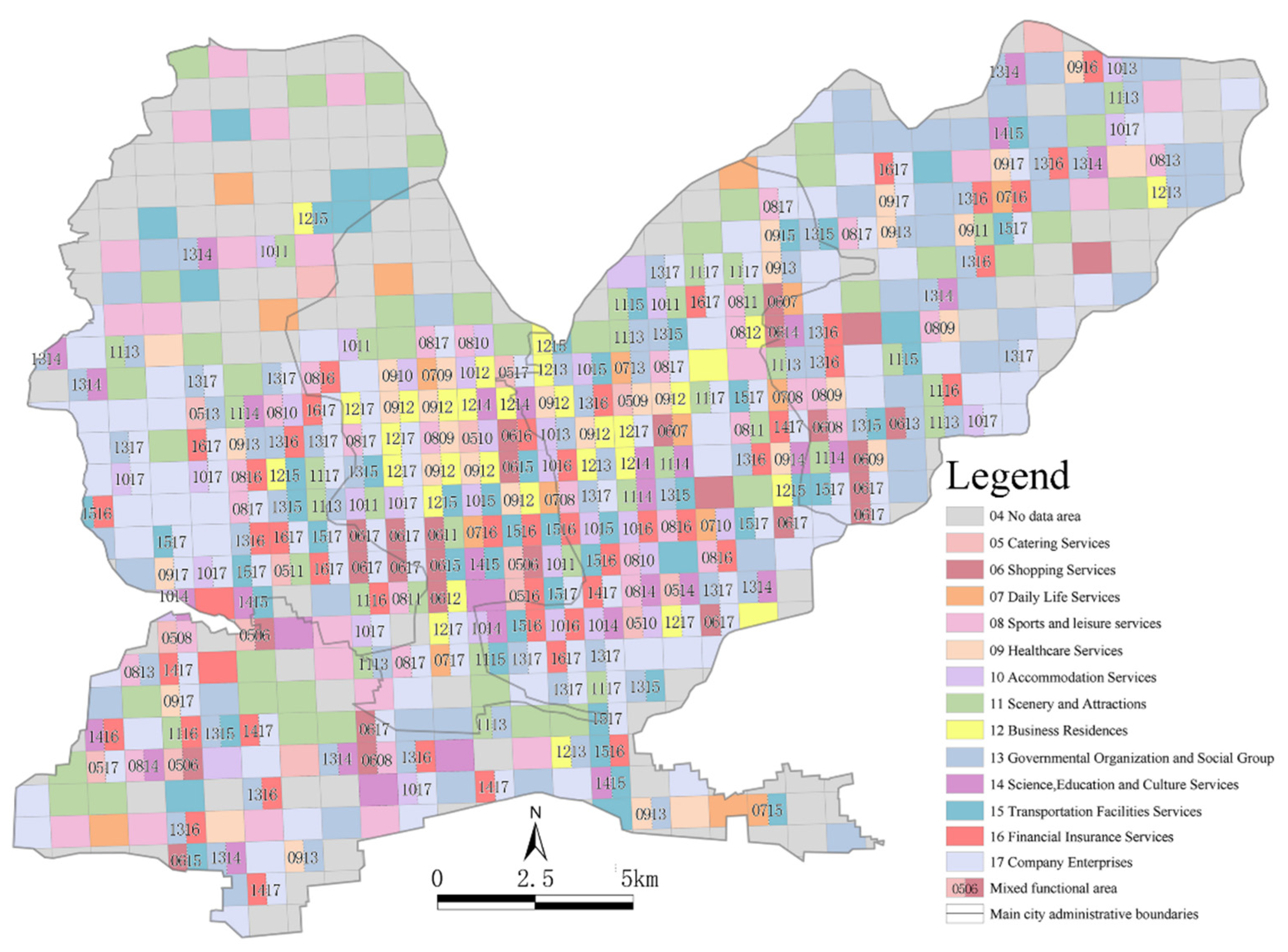



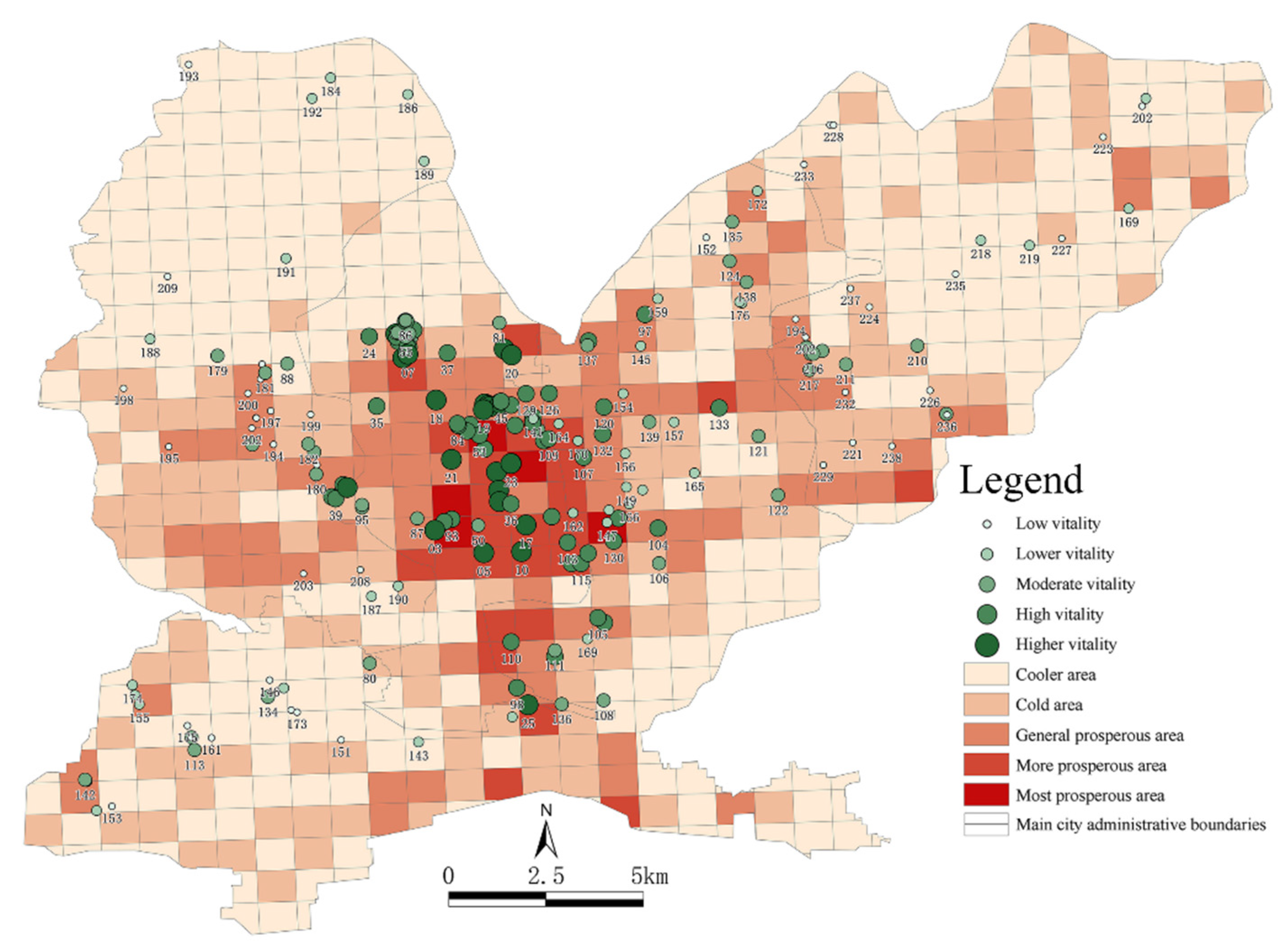

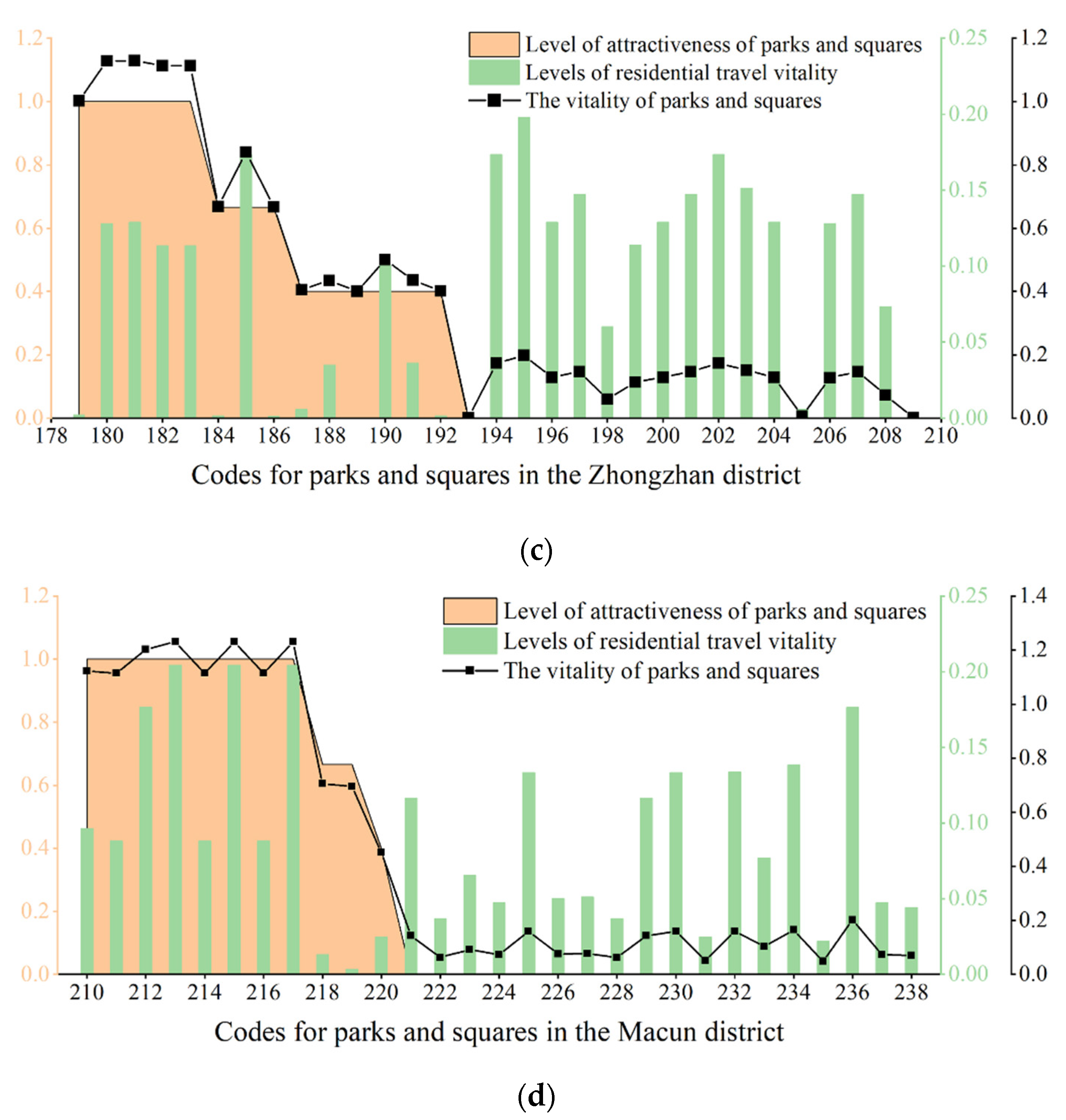
| Code | Category | POI Contents |
|---|---|---|
| 05 | Catering Services | Chinese restaurants, foreign restaurants, fast food restaurants, tea houses, casual dining places, pastry stores, dessert stores, coffee shops, cold drink stores |
| 06 | Shopping Services | Shopping malls, supermarkets, convenience stores, specialty stores, buildings, home appliance and electronic stores, home building material markets, clothing, shoe, hat, and leather goods stores |
| 07 | Daily Life Services | Beauty salons, photography and printing stores, laundromats, telecommunications offices, maintenance sites, post offices, moving companies, bathing and massage places, baby service places |
| 08 | Sports and Leisure Services | Entertainment venues, sports and leisure service venues, leisure venues, vacation and recreation venues, sports venues, theaters, golf-related |
| 09 | Healthcare Services | Medical and healthcare sales stores, clinics, general hospitals, specialty hospitals, healthcare services, emergency centers, veterinary clinics, disease prevention centers |
| 10 | Accommodation Services | Hotel guest houses, hotels, accommodation services-related |
| 11 | Scenery and Attractions | Park square, scenic spot, scenic spot-related |
| 12 | Business Residences | Residential areas, business residential-related, industrial parks, buildings |
| 13 | Governmental Organization and Social Group | Government agencies, social groups, traffic vehicle management, government, and social groups-related, public prosecution and law agencies, industrial and commercial tax agencies, democratic parties, foreign agencies |
| 14 | Science, Education, and Culture Services | Schools, museums, science and technology museums, scientific and educational and cultural places, training institutions, literary and artistic groups, driving schools, media organizations, cultural palaces, exhibition centers, exhibition halls, libraries, planetariums, archives |
| 15 | Transportation Facilities and Services | Train stations, coach stations, bus stations, parking lots |
| 16 | Financial Insurance Services | Banks, ATMs, financial and insurance service providers, securities companies, insurance companies, finance companies, bank-related |
| 17 | Company Enterprises | Companies, corporate enterprises, factories, well-known enterprises, agriculture, forestry, and fishery bases |
| Data Name | Data Form | Data Type | Volume of Data | Year |
|---|---|---|---|---|
| POI/pc | Point | Vector data | 41,902 | 2020 |
| Parks and squares/pc | Point | Vector data | 238 | 2020 |
| WorldPop/pc | Grid | Raster data | 721 | 2020 |
| OpenStreetMap/strip | Line | Vector data | 1216 | 2020 |
| Major Categories | Minor Categories | Attractiveness Weighting |
|---|---|---|
| Public Recreation | City squares, parks, public recreation buildings | 1 |
| Nature, General | Natural scenic spots, nature reserves, forest parks, geological parks, wetland parks | 0.75 |
| Cultural Venues | Memorial halls, cultural halls, museums, aquariums | 0.55 |
| Historic Sites | Ruins, ancient buildings, ancient gardens, tombs and mausoleums, places of worship and religious activities | 0.25 |
| Category | Public Awareness | Category | Public Awareness |
|---|---|---|---|
| 05. Catering Services | 55.62 | 12. Business Residences | 30.57 |
| 06. Shopping Services | 81.46 | 13. Governmental Organizations and Social Groups | 35.50 |
| 07. Daily Life Services | 81.46 | 14. Science, Education, and Culture Services | 67.06 |
| 08. Sports and Leisure Services | 50.10 | 15. Transportation Facilities and Services | 100.00 |
| 09. Healthcare Services | 50.69 | 16. Financial Insurance Services | 30.57 |
| 10. Accommodation Services | 55.62 | 17. Company Enterprises | 30.57 |
| 11. Scenery and Attractions | 82.45 |
| Type | Park Size (hm2) | Size of Population Served (10,000 People) | Service Radius (m) | |
|---|---|---|---|---|
| Integrated Parks | ≥50.0 | >50.0 | >3000 | |
| 20.0–50.0 | 20.0–50.0 | 2000–3000 | ||
| 10.0–20.0 | 10.0–20.0 | 1200–2000 | ||
| Residential Park | Community Park | 5.0–10.0 | 5.0–10.0 | 800–1000 |
| 1.0–5.0 | 1.5–2.5 | 500 | ||
| Garden Tour | 0.4–1.0 | 0.5–1.2 | 300 | |
| 0.2–0.4 | — | 300 | ||
| Urban Areas | District Administrative Area (km2) | Service Coverage Rate C (%) | Service Overlap Rate O (%) | Relative Service Level |
|---|---|---|---|---|
| Jiefang District | 71.71 | 80.25% | 50.19% | Higher |
| Shanyang District | 174.20 | 40.38% | 52.09% | General |
| Zhongzhan District | 125.00 | 26.50% | 52.40% | Lower |
| Macun District | 118.90 | 28.60% | 50.71% | Lower |
Publisher’s Note: MDPI stays neutral with regard to jurisdictional claims in published maps and institutional affiliations. |
© 2022 by the authors. Licensee MDPI, Basel, Switzerland. This article is an open access article distributed under the terms and conditions of the Creative Commons Attribution (CC BY) license (https://creativecommons.org/licenses/by/4.0/).
Share and Cite
Wang, T.; Li, Y.; Li, H.; Chen, S.; Li, H.; Zhang, Y. Research on the Vitality Evaluation of Parks and Squares in Medium-Sized Chinese Cities from the Perspective of Urban Functional Areas. Int. J. Environ. Res. Public Health 2022, 19, 15238. https://doi.org/10.3390/ijerph192215238
Wang T, Li Y, Li H, Chen S, Li H, Zhang Y. Research on the Vitality Evaluation of Parks and Squares in Medium-Sized Chinese Cities from the Perspective of Urban Functional Areas. International Journal of Environmental Research and Public Health. 2022; 19(22):15238. https://doi.org/10.3390/ijerph192215238
Chicago/Turabian StyleWang, Tongwen, Ya Li, Haidong Li, Shuaijun Chen, Hongkai Li, and Yunxing Zhang. 2022. "Research on the Vitality Evaluation of Parks and Squares in Medium-Sized Chinese Cities from the Perspective of Urban Functional Areas" International Journal of Environmental Research and Public Health 19, no. 22: 15238. https://doi.org/10.3390/ijerph192215238
APA StyleWang, T., Li, Y., Li, H., Chen, S., Li, H., & Zhang, Y. (2022). Research on the Vitality Evaluation of Parks and Squares in Medium-Sized Chinese Cities from the Perspective of Urban Functional Areas. International Journal of Environmental Research and Public Health, 19(22), 15238. https://doi.org/10.3390/ijerph192215238






